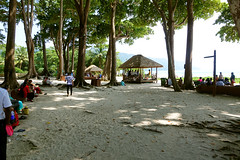I am always thrilled to come home to lovely surprises. And this is precisely what had happened last week after I returned home from a nearly fortnight-long work-related travels – a pile of travel books that are patiently waiting to be read. And so, for the next few weeks, just like my previous post, I’ll be sharing my views on some of these books. The next one of the lot is an impressive coffee table book Life in Spiti by the noted Himalayan photographer Himanshu Khagta.
I have been a keen follower of Khagta’s works ever since he started to post his photo stories online. Life in Spiti is one of his photo projects to compile which he spent close to six months in the harsh environs of Spiti during the winters of 2014. Through this project, Khagta is trying to not only capture the beauty of the terrain or its people but the rigours of daily life of locals in winters when the temperature reaches minus 30 or even 40 degree Celsius. Isolated by arduous high mountain passes on both sides of the Spiti River, the trans-Himalayan valley gets virtually cut off from the rest of the world during winters after extreme snowfall. With very limited healthcare facilities and connectivity in the entire valley, winters prove to be a real test for locals as well as administration. Electricity is a sheer luck. Khagta recalls spending as much as 45 days without electricity in one go during the period he stayed there to collate the data for his project.
Forget spending an entire winter season in total absence of even typical village-like material comforts, though it may seem strange, a week in prime travel season here is dreaded by most compelled visitors. The valley is stretched on the northern side of the Great Himalayan Range on the north-eastern fringe of Himachal Pradesh. Through road, Spiti’s administrative headquarter Kaza can be accessed after a couple of days of drive from the state’s capital Shimla. Surrounded by treacherous terrains of Kullu, Lahaul, Ladakh, Kinnaur and Tibet, the valley nowadays is increasingly visited by adventure-seekers but mostly during summers. Quite naturally, much has been shared, published or photo-recorded from Spiti during this prime travel and adventure season. Khagta’s project has to be the first real visual lead insofar as documenting winter life of Spiti is concerned.
The book Life in Spiti comprises not all but 152 tastefully selected beautiful photographs from the time he spent in Spiti to compile the data and make photographs for his project. The valley’s social and religious fabric gets shaped from the imposing Buddhist monasteries that become alive with the participation of locals during the long winter season every year. With nothing else to do, winters are also the best time for the locals to renew their social ties and partake in the religious ceremonies. Khagta has patiently captured many such moments; the highlight being the records from a traditionally held marriage ceremony. The white Spiti, blue skies, barren but snowy mountains, light pollution-free night skies, ornamented outfits, monastic robes and winter chores, etc. are my hints from the content of this book.
Like in most modern coffee table photo books, the captions to the photographs in Life in Spiti are listed at the end of the book. This might irk an engaged reader but an informed photo enthusiast is thoroughly going to enjoy the style. The hardbound book will not occupy any extra space than a typical book. As for the variety in the photographs, I’d have wanted him to include a few more landscapes, especially highlighting the different moods of important peaks and passes of the region. The photos are centred on Kaza and its north upper portions and the Pin Valley, Losar, Dhankar and Tabo regions are not part of this book. May be we get to see those in the next book from this project.
I totally recommend this book to a mountain and Himalayan lover or a landscape and street photographer.
Finer Info
Publisher: Self-published
Total Pages: ~ 160
Price: Rs 2,999
Where to Buy: Life in Spiti or Amazon.in
 bNomadic
bNomadic











This one looks promising for a non fiction noob. Lets see!
You’d love it. The photographs are captivating. 👍💐